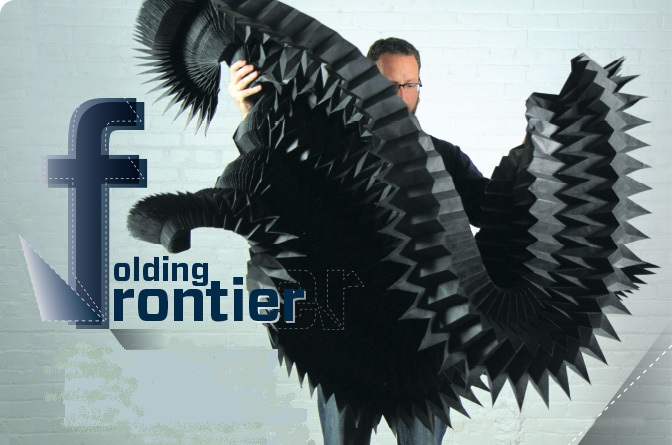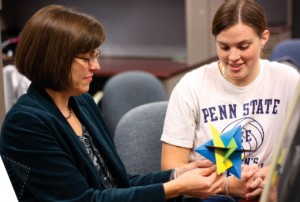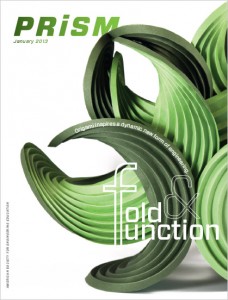Origami Engineering

Could origami engineering be the next big thing in manufacturing?
The research of David Gracias certainly resembles the hobby of folding paper — as does the way, under his microscope, nano-materials fold themselves into cubes and pyramids.
But please don’t say it’s cute. “I hate the word cute; I’m not in the business of doing ‘cute,’” protests Gracias, associate professor of chemical and biomolecular engineering at Johns Hopkins University. Until recently, “origami was treated like a game,” he says. The pioneers who incorporated the ancient Japanese art into high technology were both lonely and frequently mocked. “That a real scientist could do something useful with it was treated with skepticism. They would say, ‘How cute.’” Recalls University of Illinois at Urbana-Champaign civil engineer Glaucio Paulino: “People did not believe in this idea. They said it looks funny.”
No longer. With practical implications ranging from minimally invasive surgical aids to highly efficient capture of solar energy and giant space telescopes that fit into a small payload, origami engineering has evolved into a well-funded fount of innovation. In 2009 the Gracias Laboratory created the world’s smallest precisely patterned cube, a self-folding structure just 100 nanometers long on each side. Two years later, in a collaboration with researchers at the Johns Hopkins Medical School, hundreds of self-folding microgrippers were deployed and then retrieved to successfully biopsy the bile duct of a live pig. These were the world’s first untethered submillimeter surgical devices.
Origami’s growth took a new turn in 2012, when the National Science Foundation launched the Origami Design for Integration of Self-assembling Systems for Engineering Innovation (ODISSEI) program and granted some $16 million to 14 universities, with millions more to come. Paulino, who helped raise the mast of ODISSEI, says the NSF was looking for “the next topic in engineering — a vision toward the future,” adding, “We felt origami was such a project.” One of the grant recipients, Max Shtein of the University of Michigan, strongly concurs. “We’re wading into a sea of possibilities,” says the materials science and engineering professor. “There are a million different applications for engineering out of this stuff.”
What these researchers are producing, however, rarely bears any resemblance to a Japanese paper crane.
Engineers typically fold sheets of shape-memory alloys or polymers into three-dimensional devices. The differences between these materials and paper highlight both the challenges and the possibilities of origami engineering. Unlike paper, these sheets can be coated in semiconductors and programmed to fold themselves. “We envision smart sheets, so that if you need anything you just tell the sheets, ‘Make me a plate or make me a cup; make me a chair or make me a tool,’ whatever that tool is,” says Daniela Rus, director of the Computer Science and Artificial Intelligence Laboratory at the Massachusetts Institute of Technology. Rus, along with engineering and math colleagues at MIT and Harvard, has already produced a small, hinged sheet that can fold itself into a boat and then into a paper-airplane shape.
 But also unlike paper, most of these materials have meaningful — and troublesome — thickness. Paper creases; a polymer or a metal can at best make a tight bend. MIT mathematician Erik Demaine has been modeling origami math for more than 15 years and even earned a MacArthur “genius grant” for “solving difficult problems related to folding.” One of his early publications proved that “everything is foldable,” according to Demaine. “If you have a large enough sheet of material, you can bend it into any shape you want.” But, Demaine admits, “almost all the math models assume no thickness — we need algorithms to model thickness and minimize it in folding.”
But also unlike paper, most of these materials have meaningful — and troublesome — thickness. Paper creases; a polymer or a metal can at best make a tight bend. MIT mathematician Erik Demaine has been modeling origami math for more than 15 years and even earned a MacArthur “genius grant” for “solving difficult problems related to folding.” One of his early publications proved that “everything is foldable,” according to Demaine. “If you have a large enough sheet of material, you can bend it into any shape you want.” But, Demaine admits, “almost all the math models assume no thickness — we need algorithms to model thickness and minimize it in folding.”
Mary Frecker and graduate student Adrienne Crivaro discuss the design of a three dimensional origami structure. IMAGE COURTESY OF MARY FRECKER, PSU
Still, engineers are finding they have much to learn from the artists who work in paper. Shtein’s desk in Ann Arbor, Mich., is scattered with folded paper forms created by a collaborator from U of M’s School of Art and Design, Matt Shlian. “Watch this!” the engineer exclaims as he stretches a tessellated sheet of mountains and valleys that undulates in the air and then collapses between his palms. Shtein says that his own expertise in engineering materials had flattened his worldview until he began working with the artist. “He had three dimensions kind of hard-wired into him,” according to Shtein. Now he heads a $2 million NSF-funded research project, collaborating with four other engineers and Shlian to explore the folding of thin films into photonic devices.
The ODISSEI grant prospectus compelled engineering teams to find artistic coinvestigators, which was a mental stretch for some. “I was sk eptical about stepping outside of our sandbox,” confesses chemical engineer Michael Dickey of North Carolina State University. Then he spent an afternoon touring the College of Design on campus. “I was surrounded on every side by 40 or 50 artistic costumes, each folded out of a single sheet of paper,” Dickey recalls. He snapped photographs on his phone and returned to the lab with three or four new ideas to apply to NC State’s ODISSEI research project. “I’m a convert,” he adds.
eptical about stepping outside of our sandbox,” confesses chemical engineer Michael Dickey of North Carolina State University. Then he spent an afternoon touring the College of Design on campus. “I was surrounded on every side by 40 or 50 artistic costumes, each folded out of a single sheet of paper,” Dickey recalls. He snapped photographs on his phone and returned to the lab with three or four new ideas to apply to NC State’s ODISSEI research project. “I’m a convert,” he adds.
This blog post is excerpted from Folding Frontier, ASEE Prism magazine’s January 2013 cover story.
Filed under: Special Features
Tags: ASEE Prism, David Gracias, Johns Hoplins, manufacturing, Materials Engineering, MIT, origami engineering, paper folding, Penn State, STEAM








